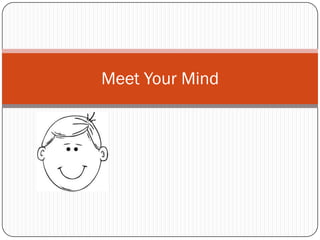
Meet your mind
- 2. The Traditional View of the Mind The mind is “the element of a person that enables them to be aware of the world and their experiences, to think, and to feel” (Wikipedia) The above definition of the mind describes quite well the everyday understanding of what is “our mind” However, this everyday understanding of the mind does not recognize the overwhelming influence of subconscious processes on virtually every function of the mind (awareness of the world, thinking, feeling) mentioned above For that we need to look at the underlying physical system, i.e. the nervous system
- 3. The Nervous System As the illustration shows, the nervous system has three basic parts, namely: 1. The central nervous system which includes the brain and the spinal cord 2. the peripheral nervous system linking the brain and spinal cord to the sensory organs and muscles or glands that release hormones 3. The autonomic nervous system which manages everything else in our body ranging from managing body temperature, keeping the heart pumping, dilating eyes, breathing, digesting
- 4. Building Blocks of the Nervous System The building block of the nervous system is the nerve cell, or neuron Each neuron is composed of • a cell body which is like a min-brain in sense that it processes, i.e. determines an appropriate response to an external stimulus (as provided by the sensory organs like eyes and ears) or to a message received from other neurons • An axon which is like a microphone in the sense that the cell “talks” to other cells to which it has a connection, called synapse • dendrites which are like earphones in the sense that the cells “listens” to what other cells it is connected with have to say to it
- 5. Building Blocks of the Nervous System Source: http://spiritrambler2.blogspot.com/
- 6. Neural Networks The nervous system is composed of 100 billion neurons in the brain alone, with additional cells in other parts of the nervous system described earlier An average cell may be connected to from one thousand to ten thousand other cells Cells in a given part of the nervous system are connected to other cells in that part or other in other parts of the nervous system to form “neural networks”
- 7. Neural Networks Each neural network carries out a specific function For example, the visual network describes the photons of light entering our eyes to specific parts of the brain which, after seemingly instantaneous but nevertheless extremely sophisticated internal processing by the subconscious, is presented to the conscious part of our brain as what our “eyes are seeing” A vast variety of the functions of our nervous system, ranging from causing heartbeats and digestion to walking and running and memorizing to determining various aspects of our personality have been traced to specific neural networks
- 8. Neural Networks and Our Personality Our personality has been shown to be shaped by the operation of specific neural networks For example, some people are resilient in the sense that they can take serious setbacks in a stride, while others find life unbearable to the extent that similar setbacks would send them into depression These differences are reflected in the physical nature of a neural network that has been named the “Resilience Network” More resilient people have been found to have specific parts of the Resilience Network to actually have thicker nerves present there than in less resilient people!
- 9. Strengthening our Personality Other networks have been identified whereby some people are more motivated than others, some have social skills that others lack and so forth Thus our resilience to stress, motivation, focus, social skills are reflected in the physical nature of the underlying neural network In addition, it has been shown that just as there is an underlying physical basis for our thoughts and personalities, our thoughts can bring about physical changes in the underlying neural networks as well
- 10. End